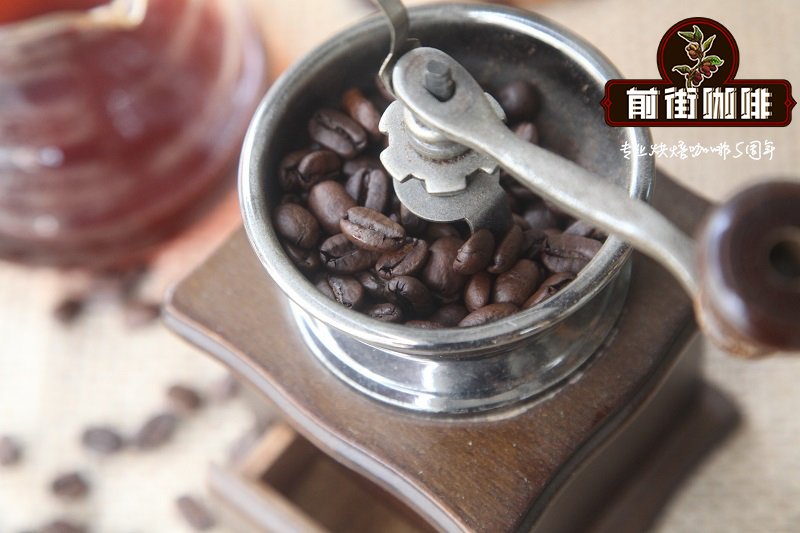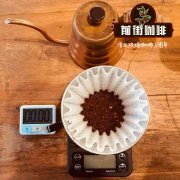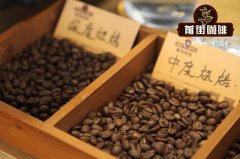Taste difference between coffee red honey treatment and black honey treatment _ how much is a packet of coffee beans treated with honey

Professional coffee knowledge exchange more coffee bean information please follow the coffee workshop (Wechat official account cafe_style)
In recent years, individual coffee has become increasingly popular, and more and more people will make their own coffee at home, and when they choose and buy coffee beans, they always see confusing terms such as washing, tanning, honey treatment and so on on the package. what are these different treatment methods all about? What kind of influence do they have on the flavor of coffee? If you know the difference in this bag, you won't grab a bag when you buy it next time.
Before we begin to introduce the treatment, we have to introduce "coffee cherry" to you. As mentioned in previous articles, coffee beans are the seeds inside the coffee fruit. Coffee trees produce coffee fruit, which turns bright red when ripe, and is also known as "coffee cherry" because it looks like a cherry.
Coffee cherries need to be processed to remove the external structure, including exocarp, pulp, pectin, endocarp and silver peel. After all these are shaved, the inside is the fruit in the shape of our common coffee beans. Therefore, the real coffee bean packaging seen on the sun, washing, honey treatment, is how to remove the peel, pulp, pectin and other different ways to get the name. At this point, you will wonder, who is going to decide what processing method to use to deal with the beans? There may be more than one factor to consider, but the most cost-effective treatment method is most often determined by the natural conditions of the producing area (such as easy access to water resources and adequate sunlight). (of course, some manors may adjust their treatment according to the demand of flavor when they have sufficient resources and have a choice.)
Solarization (Natural)-the oldest treatment
It is widely used in sunny, less water-rich and less affluent areas (such as Ethiopia). The sun drying method makes the coffee fruit dry naturally, and the coffee beans can be ripened naturally inside the fruit. Therefore, the coffee beans treated by the sun will enlarge their own flavor, mellow, strong flavor, sweet and sour unrestrained.
Remove floating beans
In order to remove the immature inferior beans, the coffee beans will be poured into a large tank, the ripe and full fruits will sink to the bottom of the water, and the bad ones will surface, and the floating beans on the surface will be removed.
Sun drying
Spread the coffee fruit evenly in the exposure field, turn it several times a day, and cover it at night to avoid dampness. This process usually lasts about 2-3 weeks (depending on the local climate), and when the water content inside the coffee bean drops to 10-14%, the sun drying step is completed.
Remove the shell
After the exposure, the outer layer of the coffee seed has been dry and hard, and then use a sheller to remove the shell.
Advantages: in addition to the steps of removing floating beans, the sunburn method does not need to use water, and a bucket of water can be reused at a low cost.
Disadvantages: because coffee beans must be placed outside, there are often many impurities such as withered branches and leaves mixed with them. And it is the use of the energy of the sun, the degree of drying of coffee beans is not easy to control, resulting in coffee fruit will be "too much", so that coffee beans are damaged. In addition, the whole fruit is exposed to the sun, so it is often moldy and rotten.
Water washing (Washed)-the most extensive treatment method
In some countries with frequent rain and high humidity, although the process is relatively tedious, it is the most widely used treatment method at present. Because of the use of a lot of water washing method, the flavor and taste are quite clean. Most of the washed coffee beans have bright acidity and aromas of flowers and fruits.
Remove floating beans (same sun method)
In order to remove the immature inferior beans, the coffee beans will be poured into a large tank, the ripe and full fruits will sink to the bottom of the water, and the bad ones will surface, and the floating beans on the surface will be removed.
Remove the peel and pulp
Through the pulp screening machine (pulping machine), remove the exocarp and pulp of the coffee fruit (leaving pectin, endocarp and silver peel).
Ferment
Put the coffee fruit treated by the pulp screening machine into the fermentation tank for 16 hours and 36 hours, the fermentation bacteria will dissolve the pectin.
Cleaning
After the completion of fermentation and removal of pectin, in order to clean the residual fermentation bacteria and impurities on the coffee beans, it will consume a lot of water and wash the coffee beans again.
Drying and removing endocarp and silver peel
The coffee fruit is usually dried by machine (or sun-drying) (reducing the moisture content to 1014%). Then use the sheller to remove the remaining endocarp and silver peel, that is, to complete the processing.
Advantages: the washing method removes the pulp from the beginning, so there is no need to worry about mildew like the sun method. And all the processing procedures are indoor, so the coffee beans have less impurities and more complete appearance.
Disadvantages: a large amount of water will be used, and the procedure is complex and tedious, so the cost is much higher than that of tanning.
Honey treatment (Honey Process)-the most ramming treatment
Honey treatment method, also known as half-sun method (semi-natural), is an improved type of sun method. The flavor of honey treatment will be affected more finely and deeply because of the residual sugar in the pectin layer. The more residual in the pectin layer, the stronger the flavor.
Remove floating beans (same sun method)
Pour the coffee beans into a large tank, the underdeveloped inferior beans will surface, and the ripe and full fruits will sink to the bottom of the water. At this time, the floating beans on the surface will be removed, that is, the steps of removing floating beans will be completed.
Remove peel and pulp (same washing method)
Through the pulp screening machine (pulping machine), the exocarp and pulp of coffee fruit are removed. It leaves pectin, endocarp and silver peel.
Unlike water washing, coffee farmers can choose the amount of pectin layer retained, which also divides honey-treated coffee beans into yellow honey, red honey and black honey treatment.
Yellow honey-(retains 30% of the pectin layer) in order to complete the sun more quickly, it must be carried out in the least shaded environment (clouds, shade trees) to get a yellow appearance.
Red honey-(retaining 50% of the pectin layer) takes a long time and requires some manual shielding to reduce the exposure intensity and extend the exposure time.
Black dense-(retaining 70% to 80% of the pectin layer) takes the longest time and is usually covered artificially to reduce exposure intensity and extend exposure time.
There are also two kinds of white honey (10%) and golden honey (90%). The more pectin retained, the sweeter and thicker the taste, but due to the need.
Sun drying
The coffee beans with pectin are directly exposed in the exposure field, so that the water content is reduced to 10-14%.
Remove pectin and endocarp
With a special machine, remove pectin and endocarp, that is, complete the treatment steps.
Advantages: since the pulp is removed in the first place, there is no mildew problem. It does not need to consume a lot of water, and the cost is low.
Disadvantages: processing steps can be said to be the most complex and labor-intensive of all ways.
Wet stripping (Wet-Hulling)-the rarest treatment method
Wet stripping, also known as semi-washing, is most commonly used in Sumatra, Indonesia (Sumatra). Because of the treatment process, the flavor of wet plucking method can be said to be complex and changeable, and the aroma of herbs, spices and medicinal materials is the overall tonality. But from time to time, there will be wood, soil, musty taste, which may not be liked by some drinkers.
Basically, the wet wave method is a unique treatment method in Indonesia. Due to the humid climate, easy rain, short sunshine time, and the general economic difficulties of coffee farmers, they want to shorten the processing time of coffee beans and sell the processed coffee beans to coffee manufacturers as soon as possible.
Remove floating beans (same sun method)
Pour the coffee beans into a large tank, the underdeveloped inferior beans will surface, and the ripe and full fruits will sink to the bottom of the water. At this time, the floating beans on the surface will be removed, that is, the steps of removing floating beans will be completed.
Remove peel and pulp (same washing method)
Through the pulp screening machine (pulping machine), remove the exocarp and pulp of the coffee fruit (leaving pectin, endocarp and silver peel).
Ferment
The coffee fruit treated by the pulp screening machine was put into the fermentation tank for 10 hours and 12 hours to ferment briefly.
The first sun exposure
The fermented coffee fruit is naturally dried until the moisture content is reduced to about 35%.
Remove pectin and endocarp
Remove pectin and endocarp by manual or special machine. Due to the high water content, the internal coffee seeds are still squeezed in a wet and soft state, so the coffee beans will be in the shape of a half moon.
The second sun exposure
Coffee farmers will sell these high-humidity coffee beans directly to coffee manufacturers (heavy because of high humidity, and the price is higher). Finally, coffee manufacturers will naturally dry these coffee beans to about 10% moisture.
Advantages: an improved treatment method to reduce the water consumption of the traditional washing method.
Disadvantages: the condition and quality of coffee beans are difficult to control.
Other treatment methods
In addition to the above-mentioned refining methods, there is another method that must have been heard of but did not expect to be the treatment method, that is, the use of enzymes and digestive juices in the biological digestive tract for the treatment of raw coffee beans. to put it simply, it is to eat the fruit and excrete the coffee beans. The most famous musk coffee and Phoenix crown coffee are treated in this way. Now people are slowly trying this treatment on other animals, such as elephant coffee in Thailand, macaque coffee in India, etc. (I wonder if the sloth will be interested? )
The amount of coffee treated in this way is very rare, and the price is also very expensive, as for the flavor. Such a charming special flavor depends on people's taste! (I don't like it very much personally.)
Brand recommendation of honey treated coffee beans
The Costa Rican black honey-treated coffee beans roasted on Qianjie Coffee are fully guaranteed both in brand and quality. And more importantly, the performance-to-price ratio is extremely high, a pack of half a pound 227 grams, the price is only about 95 yuan. According to the calculation of 15 powders per cup of coffee, 15 cups of coffee can be made in a bag, which costs only about 6 yuan per cup, which is very cost-effective for coffee shops to sell dozens of yuan a cup.
Qianjie coffee: Guangzhou bakery, the store is small but a variety of beans, you can find a variety of unknown beans, but also provide online store services. Https://shop104210103.taobao.com
Important Notice :
前街咖啡 FrontStreet Coffee has moved to new addredd:
FrontStreet Coffee Address: 315,Donghua East Road,GuangZhou
Tel:020 38364473
- Prev

Honey-treated coffee bean grading system _ are Costa Rican coffee beans treated with black honey?
Professional coffee knowledge exchange more coffee bean information Please pay attention to the coffee workshop (Wechat official account cafe_style) after the coffee fruit has been planted and harvested in the manor, then there is the most important step in addition to the variety, planting site and other most important steps of post-processing. At present, most of the treatment methods are mainly sun exposure, semi-washing and washing, as well as several special honey treatments.
- Next

Honey treated coffee beans recommended _ honey treated coffee what is the taste of coffee? what are the honey treatments for coffee?
Professional coffee knowledge exchange more coffee bean information please pay attention to the coffee workshop (Wechat official account cafe_style) honey treatment of coffee beans unique: coffee beans ripe fruit skin is red from the fruit freshly peeled coffee beans more or less with some pectin-like transparent mucus after washing, put the raw beans with pectin into the tank, the fermentation process decomposes the pectin stickiness
Related
- What is the meaning of lactic acid fermentation with coffee bean treatment?
- How to judge the state of foam by sound?
- How does the latte pull out the unicorn pattern? Come to get for a little trick to improve the flower pull!
- Will flower pulling affect the taste of the latte?
- Do you know the history of coffee?
- The difference between honey treatment and sun washing what is raisin honey treatment?
- What kind of milk can a novice use to make coffee foam to keep the foam longer? The correct method and skills of milking tutorial sharing
- Why do washed coffee beans taste sour? Flavor characteristics of washed Coffee
- Introduction to the skill of how to practice the size and height of water injection around the circle of hand-brewed coffee
- How do beginners practice coffee flower drawing from scratch?

